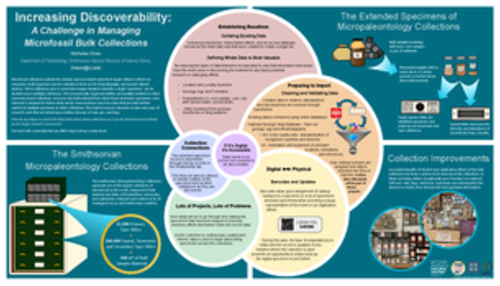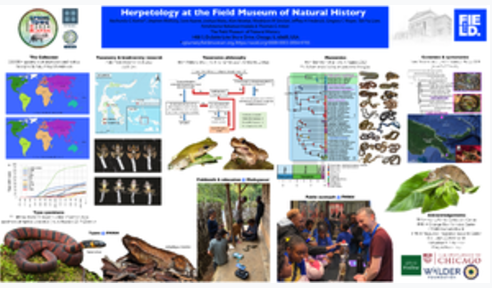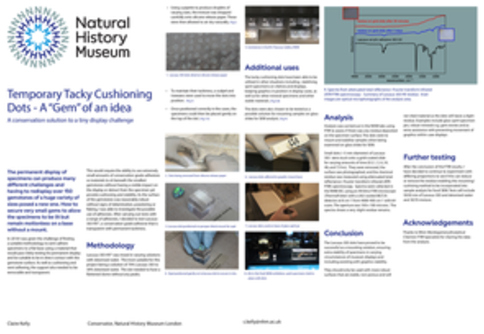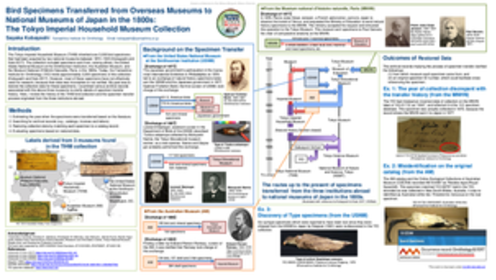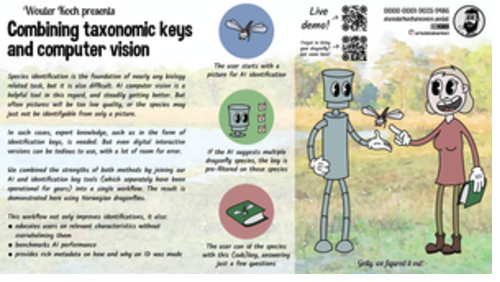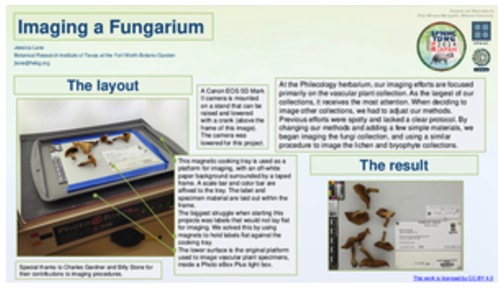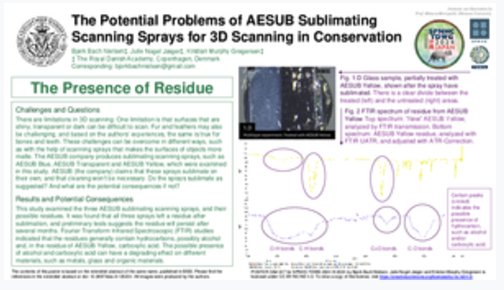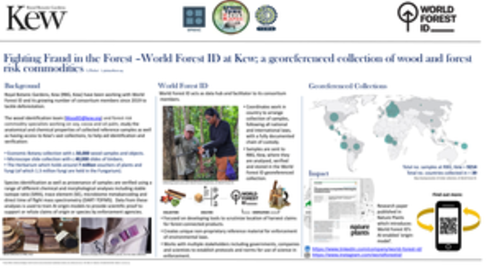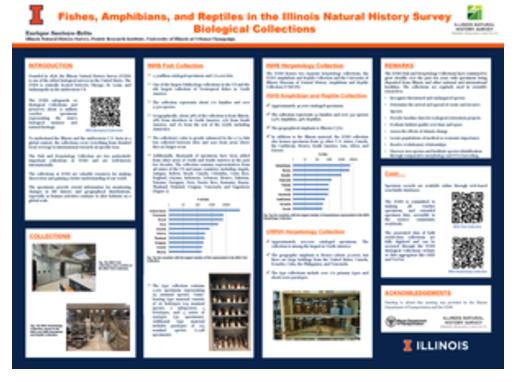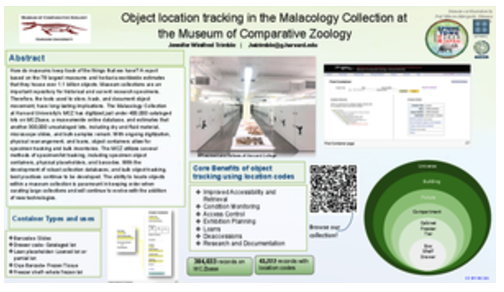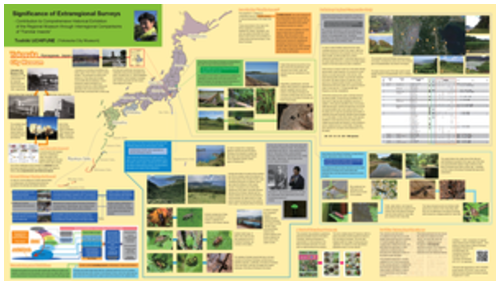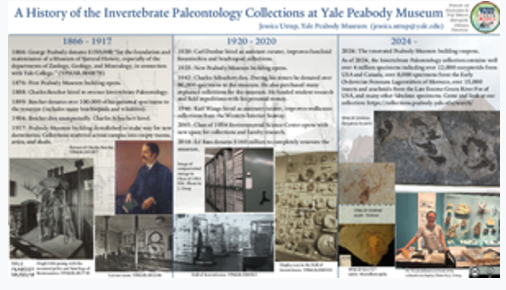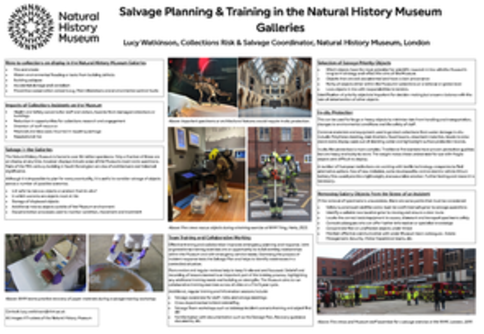Posters
Posters presented at SPNHC-TDWG 2024
Posters
Table of Contents
Abstracts
From Manual to Automated: Enhancing Publication Tracking at the California Academy of Sciences Using the OpenAlex API
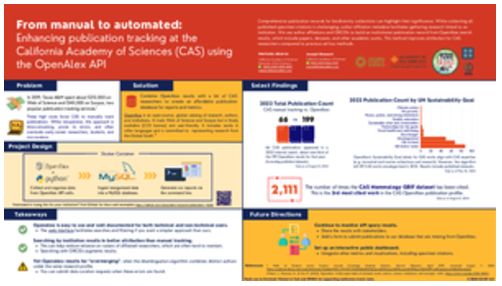 Maricela Abarca ORCID iD1,2, Joseph Russack ORCID iD1
Maricela Abarca ORCID iD1,2, Joseph Russack ORCID iD1
2University of San Francisco, San Francisco, California, USA.
Abstract
Although publications alone are not a comprehensive measure of the impact of biodiversity collections, they provide a valuable starting point for formulating impact metrics due to the accessible and standardized nature of publication metadata. The ubiquity of attributes such as DOIs, author affiliation, and the increasing adoption of author identifiers such as ORCIDS facilitate automated collection and analysis of publication data. One useful and emerging area of publication metadata is the assignment of UN Sustainable Development Goals, which offer a direct linkage between collections based research and solutions to climate change and sustainability initiatives.
At the California Academy of Sciences (CAS), the tracking of institutional publications was initially a manual process, conducted as needed using spreadsheets and documents. Recognizing the inefficiencies and potential for errors in this method, CAS aimed to develop an automated, reliable tracking system. The integration of publications from diverse sources posed a challenge, yet it was successfully addressed using the OpenAlex API, an open-source repository of publication data. Querying the API using affiliation metadata alone resulted in a significant improvement in publication tracking, and further refinement was achieved by incorporating ORCID-based searches and filters. In the calendar year 2022, while staff manually tracked 66 publications for reporting purposes, the API system successfully identified 198 publications authored by museum staff and affiliates during the same period. The API is also equipped to retrieve datasets published through platforms like Zenodo, Figshare, and other DataCite affiliates. It returned 22 CAS datasets, a metric that was previously untracked.
Components of the publication tracking application include a MySQL database of publications and institutionally affiliated authors, as well as an automated email reporting system for tables and visualizations of publication data. Examples of these reports, including visualizations related to Sustainable Development assignments can be found at https://github.com/calacademy-research/publications_finder.
A History of Marine Exploration: Expeditions and Contributors to the Marine Invertebrate Collections at the American Museum of Natural History
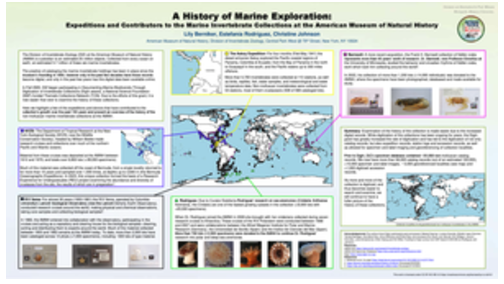 Lily Berniker ORCID iD, Estefania Rodriguez ORCID iD, Christine Johnson ORCID iD
Lily Berniker ORCID iD, Estefania Rodriguez ORCID iD, Christine Johnson ORCID iD
Abstract
The marine invertebrate collections within the Division of Invertebrate Zoology at the American Museum of Natural History (AMNH) house an estimated 5-7 million specimens and encompass more than 25 animal phyla.
Cataloging material in these collections has been in practice since the museum’s beginning more than 150 years ago. However, only in the past few decades has there been a concerted effort to catalog records and their associated data in digital format, and only in the past few years has this digital data been available online.
Since the fall of 2020, The Division of Invertebrate Zoology has been participating in Documenting Marine Biodiversity Through Digitization of Invertebrate Collections (DigIn), a National Science Foundation (NSF)-funded Thematic Collections Network (TCN). The AMNH’s objectives under this grant are to digitize the majority of the non-mollusk, fluid-preserved marine invertebrate holdings, georeference the collection localities and make available publicly thousands of specimen images. Through the efforts of this grant, the history of the collection, including major expeditions and major donors, has come into focus. With digital catalog, expedition, locality and donor records, it is now easier than ever to examine the history of these collections.
Here we present an overview of the non-molluscan marine invertebrate collections and highlight a few of the expeditions and donors that have contributed to the collection’s growth over the past 150 years.
Arctos: A Community-Driven Collection Management Solution
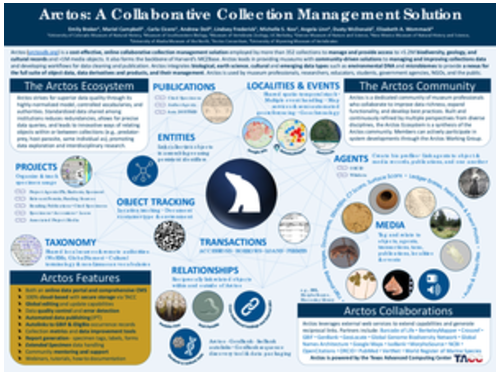 Emily Braker ORCID iD1, Mariel Campbell ORCID iD2, Carla Cicero ORCID iD3, Andrew Doll ORCID iD4, Lindsey Frederick5, Michelle S. Koo ORCID iD3, Angela Linn ORCID iD6, Teresa J. Mayfield-Meyer ORCID iD7, Dusty McDonald ORCID iD8, Elizabeth A. Wommack ORCID iD9
Emily Braker ORCID iD1, Mariel Campbell ORCID iD2, Carla Cicero ORCID iD3, Andrew Doll ORCID iD4, Lindsey Frederick5, Michelle S. Koo ORCID iD3, Angela Linn ORCID iD6, Teresa J. Mayfield-Meyer ORCID iD7, Dusty McDonald ORCID iD8, Elizabeth A. Wommack ORCID iD9
2Museum of Southwestern Biology, University of New Mexico, Albuquerque, New Mexico, USA.
3Museum of Vertebrate Zoology, University of California, Berkeley, Berkeley, California, USA.
4Denver Museum of Nature & Science, Denver, Colorado, USA.
5New Mexico Museum of Natural History & Science, Albuquerque, New Mexico, USA.
6University of Alaska Museum of the North, Fairbanks, Alaska, USA.
7Arctos Consortium, Community Initiatives, Oakland, California, USA.
8Arctos Consortium, Community Initiatives, Oakland, Colorado, USA.
9University of Wyoming Museum of Vertebrates, University of Wyoming, Laramie, Wyoming, USA.
Abstract
Arctos is a web-based collection management system and data portal serving global data on over 5.2 million biodiversity, geodiversity, and cultural object records and more than 1 million media (images, audio, CT scans, documents) from 333 collections. Premised on the core principles of standardization, flexibility, interdisciplinarity, and connectivity, Arctos provides an effective solution for managing physical and digital collections, and was developed as a collaborative model to harmonize complex information and dynamically link these data in a richly annotated digital ecosystem. Securely hosted at the Texas Advanced Computing Center, the portal (arctos.database.museum) includes numerous tools and services for managing and making accessible museum data. A web interface supports data entry and editing, with integrated tools for transaction and permit management, geocoding, mapping, documenting citations, object tracking, and automated IPT publishing. Arctos strives for superior data quality through its highly-normalized model, controlled vocabularies, and authorities. Shared standardized data has led to collective data improvements and innovative ways of relating objects within or between collections (e.g., predator-prey, host-parasite relationships), promoting data exploration and interdisciplinary research. Arctos also leverages external services to extend capabilities and generate reciprocal links with collaborators, including Barcode of Life, GBIF, GenBank, Global Biotic Interactions, Global Genome Biodiversity Network, Global Names, iDigBio, IsoBank, iNaturalist, MorphoSource, World Register of Marine Species, and VertNet. Furthermore, Arctos is an active community of museum professionals who collaborate on best practices and work together to improve data structure and system functionality, directly driving developments through participation in the Arctos Working Group (arctosdb.org). By connecting natural and cultural history collections and integrating novel information types within a shared architecture that promotes high-quality data accessibility, Arctos empowers research, education, and conservation to ultimately address pressing global challenges.
Funding Program
Arctos received a Robert & Patricia Switzer Foundation Leadership Grant (2023) and the following awards from the National Science Foundation for development and sustainability: DBI-9630909, DBI-9876837, DEB-9981915, DBI-2034593, DBI-2034568, DBI-2034577.
Increasing Discoverability: A Challenge in Managing Microfossil Bulk Collections
Abstract
Microfossil collections include the remains and associated material of single-celled or otherwise extremely small organisms and are valuable in their use for biostratigraphy and ancient climate analysis. In recent years, we have leveraged a long history of work to document these collections, particularly focused on the bulk sample material, to create the first attempt to mobilize and enable digital access to this important material from the National Fossil Collection. However, processing the bulk samples found in Microfossil collections presents many challenges for both physical and digital organization. Bulk material can include cores, large quantities of unprocessed sediments, and material that has been processed through various sized sieves. In addition, this material is managed alongside collections of type, taxonomic, and faunal slides of picked specimens that were processed from the bulk material. The data held within bulk collections are an underutilized resource of thousands of localities across the world providing a snapshot of geological time often undiscoverable by the microfossil research community.
Getting this data into an online accessible database allows greater access for the research community, encouraging increased use of the collections and improved discoverability. It also enhances the ability to properly curate the material and to digitally reunite parts of the collection that have been processed into other parts of our collection or separated between multiple institutions during acquisition. In addition, the nature of this material aligns well with the concept of the extended specimen and the complexity of connecting data across multiple occurrences, a critical detail for unlocking the value of these collections that are often overlooked. Here we show an overview of the work to standardize and combine existing data sources, fill in gaps in the data, outline the data structure necessary to properly describe these collections, and connect the data to the physical specimens.
First usage of open data for the revision of the regional Red List in Northwestern Siberia
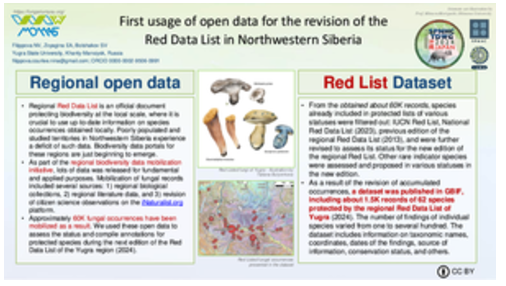 Nina Filippova ORCID iD1, Sergei Bolshakov ORCID iD2,1, Elena Zvyagina ORCID iD3,1
Nina Filippova ORCID iD1, Sergei Bolshakov ORCID iD2,1, Elena Zvyagina ORCID iD3,1
2Komarov Botanical Institute of the Russian Academy of Sciences, Saint-Petersburg, Russian Federation.
3Moscow State University, Moscow, Russian Federation.
Abstract
Regional Red List is an official document protecting biodiversity at the local scale, where it is crucial to use up-to-date information on species occurrences obtained locally. Poorly populated and studied territories in Northwestern Siberia experience a deficit of such data. Biodiversity data portals for these regions are just beginning to emerge.
The assessment of Red Lists in Khanty-Mansi Autonomous Okrug-Yugra for the past editions (2003, 2013) was based primarily on expert opinion. As part of the regional biodiversity data mobilization initiative, lots of data was released for fundamental and applied purposes. Mobilization of fungal records included several sources: 1) regional biological collections, 2) regional literature data, and 3) revision of citizen science observations on the iNaturalist.org platform.
Approximately 60K fungal occurrences have been mobilized as a result. We used these open data to assess the status and compile annotations for protected species during the next edition of the Red List of the Yugra region (2024).
From the obtained about 60K records, species already included in protected lists of various statuses were filtered out: IUCN Red List, National Red List (2023), previous edition of the regional Red List (2013), and were further revised to assess its status for the new edition. Additionally, rare indicator species were assessed and proposed in various statuses in the new edition.
As a result of the revision of accumulated occurrences, a dataset was published in GBIF, including about 1.5K records of 62 species protected by the regional Red List of Khanty-Mansi Autonomous Okrug-Yugra (2024). The number of findings of individual species varied from one to several hundred. The dataset includes information on taxonomic names, coordinates, dates of the finding, source of information, conservation status, and others.
Integrated collection and publication of sample metadata in JAMSTEC: a system maximizing the sample values and assisting the sample management.
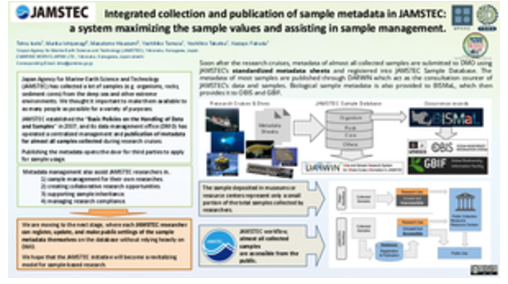 Tohru Iseto ORCID iD1, Marika Ichiyanagi2, Masatomo Hisazumi2, Yoshihiko Tamura ORCID iD1, Yoshihiro Takatsu1, Kazuyo Fukuda ORCID iD1
Tohru Iseto ORCID iD1, Marika Ichiyanagi2, Masatomo Hisazumi2, Yoshihiko Tamura ORCID iD1, Yoshihiro Takatsu1, Kazuyo Fukuda ORCID iD1
2MARINE WORKS JAPAN LTD., Yokosuka, Kanagawa, Japan.
Abstract
Japan Agency for Marine-Earth Science and Technology (JAMSTEC) has collected a lot of samples, such as organisms, rocks, sediment cores etc. from the deep sea and other extreme environments. These samples are difficult to collect by other institutions, so we thought it important to make them available to as many people as possible for a variety of purposes. JAMSTEC established the “Basic Policies on the Handling of Data and Samples” in 2007, and its data management office (DMO) has operated a centralized management and publication of metadata for almost all samples collected during research cruises. While researchers who collected samples retain priority rights of use, publishing the metadata opens the door for third parties to apply for sample usage. To properly manage and publish those metadata of the samples, DMO has constructed and operates databases. Some biological sample metadata is also shared with global databases such as OBIS and GBIF.
Traditionally, researchers have deposited selected samples in museums or resource centers and made that information public through literature or via online databases. However, the samples accessible through these routes represent only a small portion of the total samples collected by researchers. What JAMSTEC does is different from this, in that JAMSTEC publishes metadata of most collected samples.
JAMSTEC manages sample metadata not only to respond to sample requests from third parties, but also for its own benefits. Those are, assisting sample management for own researches, creating collaborative research opportunities, supporting sample inheritance, and managing research compliance.
Now that we have established this system, we are moving to the next stage, where each JAMSTEC researcher can register, update, and make public settings of the sample metadata themselves on the database without relying heavily on DMO.
We hope that the JAMSTEC initiative will become a revitalizing model for sample-based research.
Extended abstract in Biodiversity Information Science and Standards (BISS)
Professional development offerings from the iDigBio Digitization Academy
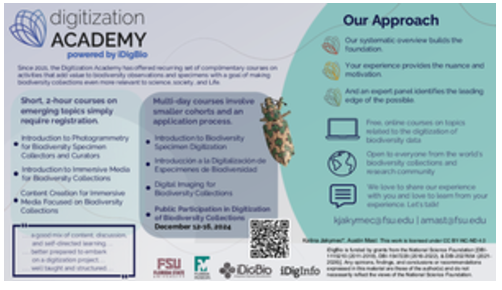 Kalina Jakymec1, Austin Mast2,1
Kalina Jakymec1, Austin Mast2,1
2Department of Biological Science, Florida State University, Tallahassee, Florida, USA.
Abstract
iDigBio (the US National Science Foundation’s National Resource for Advancing Digitization of Biodiversity Collections) is working towards a sustainable Digitization Academy that offers a set of complementary professional development courses on topics relevant to the digitization of biodiversity observations and specimens. The offerings began in 2021 with two 4-day courses: (i) Introduction to Biodiversity Specimen Digitization and (ii) Public Participation in Digitization of Biodiversity Collections. In 2022 and 2023, three additional courses were developed: (i) Digital Imaging for Biodiversity Collections, (ii) Introduction to Photogrammetry for Biodiversity Specimen Collectors, and (iii) Introduction to Immersive Media for Biodiversity Collections. With this poster, we will introduce the 2024 course offerings and other Digitization Academy resources for the community. Stop by to meet iDigBio’s Workforce Development Manager, Kalina Jakymec.
Funding Program
iDigBio is funded by grants from the National Science Foundation [DBI-1115210 (2011-2018), DBI-1547229 (2016-2022), & DBI-2027654 (2021-2026)].
An open-source OCR workflow for digitizing legacy card catalogs
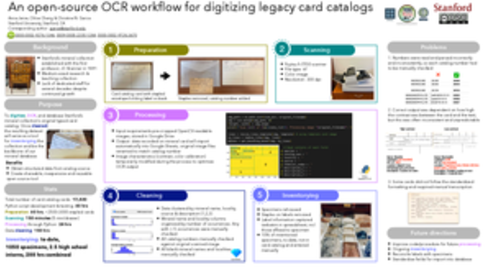 Anna Jerve ORCID iD, Chloe Cheng ORCID iD, Christine Garcia ORCID iD
Anna Jerve ORCID iD, Chloe Cheng ORCID iD, Christine Garcia ORCID iD
Abstract
Stanford University’s mineral collection was established in the late 19th century by John Casper Branner (1850 - 1922), Stanford’s first professor, first Chair of the Geology Department and co-founder of the Stanford Geological Survey (1895 - 1995). The collection grew into a significant resource for research and teaching through Branner’s fieldwork and the work of his contemporaries and subsequent workers, including many notable Stanford students. Despite its significance, a lack of dedicated management over several decades has resulted in a collection in need of modernization. Renewed interest and recognition of the importance of the collection has spurred dedicated efforts to better steward and share them more broadly. As a first step, we launched a project to digitize, OCR, and database the mineral collection’s original typed card catalog of roughly 17,500 specimen cards. Because a majority of the cards follow a standardized format, it was possible to develop a custom Python script to OCR the scanned images, convert the output into tabular data and rename the image files to include the specimen catalog number. About 60 hours were spent on script development and testing. Once developed, it took 24 hours to process the scans utilizing the script. Many cards had specimen labels stapled to them, which had to be removed before being fed through the scanner, which took 60 hours. Next steps include data cleaning in OpenRefine, as well as refinement and testing of the Python script to increase accuracy. Once cleaned, the resulting dataset will serve as the backbone of our mineral database. Improvements made to the Python script will, moreover, be useful in adapting the script for processing the other card catalogs in Stanford’s collections, and may serve as a valuable open-source tool for the broader collections community.
Herpetology at the Field Museum of Natural History, Chicago
Abstract
The collections of extant amphibians and reptiles of the Field Museum of Natural History (FMNH) is among the top dozens largest collections in the world, with over 300,000 cataloged specimens. Our regional strength is Southeast Asia and the US Midwest. Given that this is SPNCH’s first time meeting in Asia, the poster will highlight the collections’ coverage (taxonomic and geographic) with the aim for increased access to our collections for research purposes, facilitating broader scientific inquiry and collaborations. The poster will show the research outputs by FMNH-based users (staff, postdocs, research associates, PhD students, our efforts in public engagements, and collections use.
Temporary Tacky Cushioning Dots – A “Gem” of an idea A Creative Conservation Solution to a tiny Display Challenge
Abstract
The permanent display of specimens can produce many different challenges and having to redisplay over 150 gemstones of a huge variety of sizes posed a new one. How to secure very small gems to allow the specimens to be lit but remain motionless on a base without a mount.
I was given the challenge of finding a suitable methodology to semi adhere specimens to a flat base using a material that would pass Oddy testing for permanent display and be suitable to be in direct contact with the gemstone surface. As well as cushioning and semi adhering, the support also needed to be removable and transparent.
This would require the ability to use extremely small amounts of conservation grade adhesives or materials to sit beneath the smallest gemstones without having a visible impact on the display or detract from the specimen yet provide cushioning and stability. As the surface of the gemstones was reasonably robust without signs of delamination, powdering or flaking, I was able to investigate the possible use of adhesives. After carrying out tests with a range of adhesives, I decided to test Lascaux 303, a conservation grade adhesive that is transparent with permanent tackiness.
The Lascaux 303 was mixed in varying solutions with deionised water, the most suitable for this project being a solution of 70% Lascaux 303 to 30% deionised water. The dot needed to have a flattened dome without any peaks. Using a pipette to produce droplets of varying sizes, the mixture was dropped carefully onto silicone release paper. These were then allowed to air dry naturally. To maintain their tackiness, a scalpel and tweezers were used to move the dots into position. Once positioned correctly in the cases the specimens could then be placed gently on the top of the dot.
Bird specimens transferred from overseas museums to national museums of Japan in the 1800s: the Tokyo Imperial Household Museum collection
Abstract
The Tokyo Imperial Household Museum inherited bird specimens that had been acquired by two national museums between 1872–1923, including specimens of foreign species nonnative to Japan. Today, the Yamashina Institute for Ornithology holds most of this collection. I examined various archive records (e.g., catalogues, invoices, letters) associated with those museums involved to clarify details of its transfer history. The collection included specimens sent from, among others, the United States National Museum at the Smithsonian Institution, the Australian Museum, and the Muséum National d’Histoire Naturelle, Paris, in the 1800s. It also included type specimens, which are academically important. Here, I review the history of the Tokyo Imperial Household Museum bird collection and the specimens transfer process originated from the three institutions abroad.
Funding program
This work was supported by JSPS KAKENHI Grant Numbers JP 21K01005, JP24700937, JP16K01193.
Extended abstract in Biodiversity Information Science and Standards (BISS)
Combining taxonomic keys and computer vision
Abstract
We present a prototype implementation combining AI taxon recognition with standardized interactive identification keys, within our existing framework of tools.
Identifying taxa is central to biodiversity data collection. This complex task is, certainly within citizen science, increasingly aided by AI computer vision. While algorithms are improving, not everything can be identified from a picture, nor will every picture contain the necessary information. Thus, additional taxonomic knowledge is necessary, but this can be quite inaccessible for laypersons.
In this novel method, an AI model provides candidate taxa, which an identification key module uses to select a key covering all these taxa. If found, this key is pre-filtered on these taxa. Users can use this (sub-) key for further identification, typically requiring only a few inputs.
This approach provides several benefits. Primarily, identifications become more reliable than with AI alone, and broadening the key's taxon filtering beyond the AI predictions provides further quality control. Conversely, as each identification key user input is a potential for error, the reliability of this method relative to using only a key is reduced by restricting it to fewer outcomes.
Beside the identifications themselves, education is another important outcome of user tools for taxon identification. Our method teaches users relevant characteristics, without overwhelming them with full identification keys. Already prior to presenting keys, their domain knowledge may be used to describe conspicuous shared characteristics of AI predictions. E.g. "all candidates are butterflies with blue wings" is valuable information, immediately alerting users to potential recognition problems.
Finally, this workflow can store user-reported characteristics, AI predictions and pictures of observations together. Combining these, identifications can be vetted, and used to improve AI models and identification keys.
Imaging a Fungarium
Abstract
Imaging adds value to digital records by displaying materials available to researchers, and it plays a role in preservation by recording the condition of a specimen. At the Philecology Herbarium, our primary focus is on our vascular plant collection. When we began imaging the mycology collection, we had to adjust our existing imaging methods to create a new protocol for fungi. Since fungi specimens are typically smaller than vascular plants, the camera was lowered for a smaller image area. The camera aperture and shutter speed were adjusted to account for the change, and to achieve a better depth of field for three-dimensional specimens. We used a metal cooking tray to lay out fungi specimen materials and labels, along with a scale bar and color card. Small magnets keep labels flat against the tray and in focus, without obstructing data. For specimens with a single fruiting body, multiple images are taken to view all surfaces of the specimen. A hand-pump dust cleaner clears the imaging surface between each specimen to avoid cross-contamination. With these methods, we’ve begun imaging our fungi collection.
Improving the discoverability of taphonomy collections through collaborative development and systems
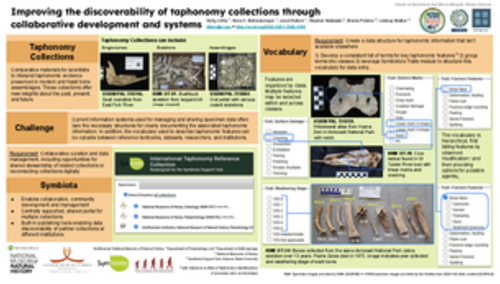 Holly Little ORCID iD1, Kay Behrensmeyer ORCID iD1, Jarod Hutson1, Stephen Maikweki2, Briana Pobiner ORCID iD1, Lindsay Walker ORCID iD3
Holly Little ORCID iD1, Kay Behrensmeyer ORCID iD1, Jarod Hutson1, Stephen Maikweki2, Briana Pobiner ORCID iD1, Lindsay Walker ORCID iD3
2National Museum of Kenya, Nairobi, Kenya.
3Arizona State University, Tempe, USA.
Abstract
Fossil and modern bones and bone assemblages representing a variety of taphonomic processes are used as comparative materials to help paleobiologists, anthropologists, archaeologists, ecologists, and forensic scientists interpret evidence of taphonomic processes. However, current information systems used for managing and sharing specimen data often lack the necessary structures for clearly documenting the associated taphonomic information. In addition, the vocabulary used to describe taphonomic features can be variable between reference textbooks, datasets, researchers, and institutions. Here we share a project that aims to address these issues through the development of an International Taphonomic Reference Collection Portal utilizing a Symbiota-based portal. Due to the collaborative nature of Symbiota communities, creation of the portal can also help to promote shared stewardship of related taphonomy collections, with a current focus on those maintained by the Smithsonian National Museum of Natural History (NMNH) and the National Museum of Kenya (NMK). Through user testing to assess an improved data model, evaluation of current structures for documenting traits, and reviews of existing vocabularies, this effort defines infrastructure updates necessary to facilitate the discovery of and broader access to critical taphonomic information needed for reference and study.
Addressing Global Biodiversity through Scaling MorphoBank for Long-Term Sustainability
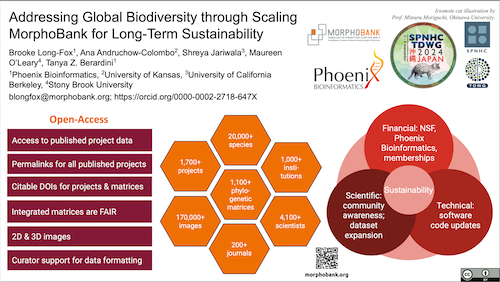 Brooke Long-Fox ORCID iD1, Ana Andruchow-Colombo ORCID iD2, Shreya Jariwala ORCID iD3, Maureen O’Leary ORCID iD4, Tanya Berardini ORCID iD1
Brooke Long-Fox ORCID iD1, Ana Andruchow-Colombo ORCID iD2, Shreya Jariwala ORCID iD3, Maureen O’Leary ORCID iD4, Tanya Berardini ORCID iD1
2University of Kansas, Lawrence, KS, USA.
3University of California, Berkeley, Berkeley, CA, USA.
4Stony Brook University, Stony Brook, NY, USA.
Abstract
Phenotypic, especially morphological, data are highly useful in systematics, taxonomy, and phylogenetics. Despite the increased use of genetic information available, phenotypic data are necessary when researching the fossil record and remain useful for living taxa by providing independent evidence for testing molecular clades. MorphoBank is a FAIR database providing open biodiversity data as morphological characters, a similar concept to GenBank for open access sequencing data. MorphoBank enables scientists to share morphological character data associated with their peer-reviewed publications in the form of phylogenetic matrices as TNT or NEXUS files with the associated 2D and 3D images, taxonomic names, and specimen information. These data can be downloaded by the public, researchers, and students in the scientific community, and reused for research. MorphoBank encourages scientists to add content in numerous ways throughout the research process, including while actively working on a morphological matrix or in conjunction with publishing a paper has a morphological matrix. MorphoBank curators add content post-publication and since the majority of the data is in journals that require a subscription, MorphoBank makes these data freely available. Data standards for morphological character matrices include scored taxa, full taxonomic names, and complete character names with state descriptions. To help ensure complete datasets are uploaded, MorphoBank has partnered with journals to ensure authors upload data matrices to MorphoBank as part of publication requirements. MorphoBank has also developed and implemented an internship program for undergraduate biology students focused on training in phylogenetic data, and is actively training volunteer curators to increase community engagement and increase data availability. MorphoBank is overhauling the website codebase for software longevity and stability as well as adding capabilities based on Artificial Intelligence to increase efficiency by automating the process of extraction of character name and state data from published articles and integrating them into the Nexus files.
Funding Program
MorphoBank is currently supported by NSF-DBI-2049965, NSF-EAR-2148768, and membership fees from academic institutions and museums around the world.
From panic to confidence: how we restored a mouldy herbarium
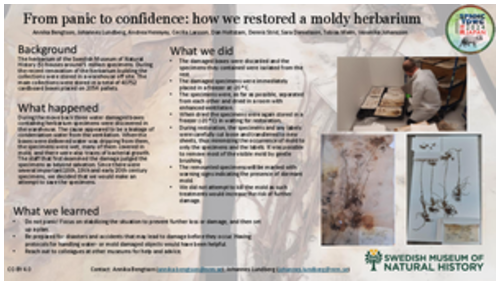 Annika Bengtson1, Johannes Lundberg2, Tobias Malm2, Andrea Hennyey2, Sara Danielsson2, Veronika Johansson2, Dennis Strid2, Dan Holtstam2, Cecilia Larsson2
Annika Bengtson1, Johannes Lundberg2, Tobias Malm2, Andrea Hennyey2, Sara Danielsson2, Veronika Johansson2, Dennis Strid2, Dan Holtstam2, Cecilia Larsson2
2Swedish Museum of Natural History, Stockholm, Sweden.
Abstract
During the renovation of the herbarium of the Swedish Museum of Natural History (S) the collections were stored in a remote warehouse. Unfortunately, water leakage in the warehouse led to several boxes of herbarium specimens being severely damaged. When discovered the specimens were wet and covered in actively growing mould. Efforts to try to save the affected specimens immediately began by stabilizing, killing and removing the mould, and restoring the specimens.
Specimens were frozen in -20 C to hinder further mould growth, and then dried in a closed area with enhanced ventilation. The slow process of trying to restore the specimens then began, including handling dislocated and damaged labels, remounting specimens and carefully removing the mould from the plants by hand. The process of restoring the specimens is presented, including what we learned about handling them without causing further damage, and how to deal with old damaged labels, but also how to work with an active mould infestation without health risks and the importance of having protocols and plans for various disasters in place before they occur.
Possibility of 3D model Collections in paleontology simply, easily, and inexpensively using portable devices equipped with LiDAR-From on-hand to room-
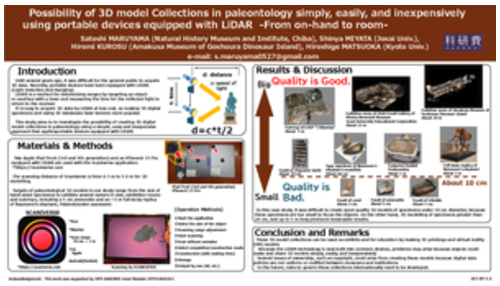 Satoshi Maruyama1, Shinya Miyata2, Hiromi Kurosu3, Hiroshige Matsuoka4
Satoshi Maruyama1, Shinya Miyata2, Hiromi Kurosu3, Hiroshige Matsuoka4
2Josai University, Chiyoda, Tokyo, Japan.
3Amakusa Museum of Goshoura Dinosaur Island, Amakusa, Kumamoto, Japan.
4Kyoto University, Kyoto, Kyoto, Japan.
Abstract
Until several years ago, it was difficult for the general public to acquire 3D data. Recently, portable devices have been equipped with LiDAR (Light Detection And Ranging). LiDAR is a method for determining ranges by targeting an object or the surface with a laser and measuring the time for the reflected light to return to the receiver. It is easy to acquire 3D data by LiDAR at low cost, so making 3D digital specimens and using 3D databases have become more popular. This study aims to consider the possibility of 3D digital model collections in paleontology simply, easily, and inexpensively using portable devices equipped with LiDAR.
Two iPad Pro (3rd and 4th generation) and an iPhone 15 Pro equipped with LiDAR are used with the Scaniverse application. The scanning range of Scaniverse is from 0.3 m to 5.0 m for 3D. Targets of paleontological 3D models in our study range from the size of on-hand specimens to meter-scale exhibition rooms and outcrops, including a 5 cm ammonite, an about 3 m full body replica of Naumann’s elephant Palaeoloxodon naumanni, and so on.
In this case, under 10 cm specimens, it is difficult to make 3D models in shape. On the other hand, 3D models from over 10 cm specimens to over 5 m rooms and outcrops are reasonably built. These 3D model collections can be used as exhibits and for education by making 3D printings and VR models.
Problems will occur because everyone can make and share 3D models simply, easily, and inexpensively. Several issues of rights such as copyrights will possibly arise from these models because digital data can move over policies of museums and institutions. In the future, we need to make rules for these rights internationally.
Funding Program
This work was supported by JSPS KAKENHI Grant Number JP22K01021.
Extended abstract in Biodiversity Information Science and Standards (BISS)
The potential problems of AESUB sublimating scanning sprays for 3D scanning in conservation.
Abstract
As 3D technology becomes more widespread, there is an increasing interest in using 3D scanning techniques in the field of conservation and restoration. Many are already using it for digitization and research purposes, or 3D reproductions of objects. 3D scanning does have some challenges when it comes to objects with shiny, transparent, bright, or dark surfaces. To make these objects more visible to the scanner, one can use various methods for making them more mat or opaque. AESUB sublimating scanning sprays are often used, and like other sprays of their kind, are useful tools when dealing with these kinds of surfaces. The fact that they sublimate and disappear on their own makes them attractive tools for conservators, who are hesitant to add material to objects that can potentially hinder future research, or in the worst cases pose a danger to the longevity and preservation of an object. But do the AESUB sublimating scanning sprays disappear completely, as implied by the manufacturer, or does something remain once the matting effect has subsided? In this thesis we tested three types of AESUB sublimating scanning sprays, and the experimental results clearly suggests that AESUB sublimating scanning sprays indeed does leave a residue, in the form of some type of hydrocarbon, on the surface of an object, even long after it has visibly disappeared. What this residue is, if such residues are left by other scanning sprays, or how the residue can potentially affect an object in the long term has yet to be determined. However, this is something we must keep in mind and be aware of if we apply these types of sprays to objects.
Extended abstract in Biodiversity Information Science and Standards (BISS)
An eDNA survey shows relatively higher diversity of coral genera in the Kerama Islands than Okinawa Island
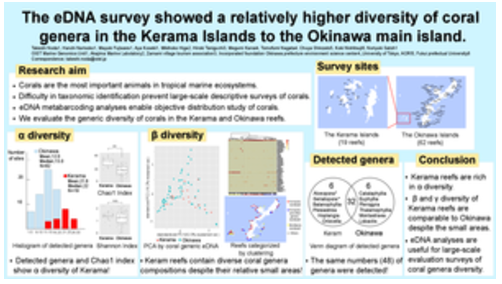 Takeshi Noda ORCID iD1, Mikihiko Higa2, Kanako Hisata1, Haruhi Narisoko1, Mayuki Suwa1, Aya Koseki1, Hiroki Taniguchi3, Koki Nishitsuji ORCID iD4, Tomofumi Nagata5, Megumi Kanai5, Chuya Shinzato ORCID iD6, Noriyuki Satoh ORCID iD1
Takeshi Noda ORCID iD1, Mikihiko Higa2, Kanako Hisata1, Haruhi Narisoko1, Mayuki Suwa1, Aya Koseki1, Hiroki Taniguchi3, Koki Nishitsuji ORCID iD4, Tomofumi Nagata5, Megumi Kanai5, Chuya Shinzato ORCID iD6, Noriyuki Satoh ORCID iD1
2Akajima Marine Science labolatory, Aka, Okinawa, Japan.
3Zamami Village tourism association, Zamami, Okinawa, Japan.
4Department of Marine Science and Technology, Fukui Prefectural University, Obama, Fukui, Japan.
5Incorporated Foundation Okinawa Environment Science Center, Urasoe, Okinawa, Japan.
6Atmosphere and Ocean Research Institute, The University of Tokyo, Kashiwa, Chiba, Japan.
Abstract
Coral reefs are one of the hotspots for biodiversity and hosting around 30% of marine species. Compositions of coral species in reefs are dynamically changing as they undergo damage and recovery, including mass bleaching event due to anthropogenic coastal development and global warming, feeding damage caused by mass outbreaks of corallivore crown-of-thorns starfish, and physical destruction due to rough water current caused by storms. Assessing coral reefs requires a precise description of coral communities within their habitat and a convenient method for doing so. Our group established an eDNA metabarcoding method that can identify reef-building coral genera. We conducted a large scale survey of coral enviromental DNA around Okinawa Island and the Kerama Islands, and compared the biodiversity of corals between them. The average number of detected genera at sampling sites in the Kerama Islands (21.6 genera) was higher than that in Okinawa Island (12.0 genera) by our methods. This result can be said to support the legitimacy of the Kerama Islands being designated as a Japanese national park due to their beautiful and diverse coral reefs. We have succeeded in clearly and objectively showing the relative richness of coral diversity in the Kerama Islands using eDNAs in this study. That is to say that eDNA metabarcoding of the scleractinian corals as the key stone group must be the one of the powerful methods for the standardization of tropical marine biodiversity.
Developing the digital museum using various images and geographic information systems
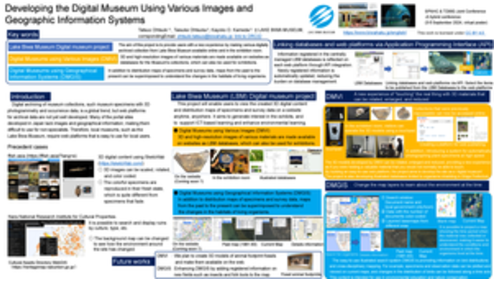 Tatsuo Ohtsuki ORCID iD, Taisuke Ohtsuka ORCID iD, Kayoko O. Kameda
Tatsuo Ohtsuki ORCID iD, Taisuke Ohtsuka ORCID iD, Kayoko O. Kameda
Abstract
Digital archiving of museum materials is a global trend, but web platforms for archival data are not yet well-developed. Many of the portal sites developed in Japan lack images and geographical information, making them difficult to use for non-specialists. Therefore, local museums, such as the Lake Biwa Museum, require a web platform that is easy to use for local users.
Recently, rapid developments in digital technology have made it easier and cheaper to customize web platforms. Furthermore, the Japanese Government now provides financial support for the digitization of materials. This has made it possible for museum staff who are not specialized in digital technology to develop web platforms. Two projects have therefore been set up.
Digital Museums using Various Images (DMVI): 3D and high-resolution images of various materials are made available on websites as electronic illustrated books, which can also be used for exhibitions.
Digital Museums using Geographical Information Systems (DMGIS): in addition to distribution maps of specimens and survey data, maps from the past to the present can be superimposed to enable an understanding of changes in the habitats of living organisms.
The 3D models developed by DMVI can be rotated, enlarged, and reduced, providing a new experience of holding valuable objects in one's hands. The DMVI project is also working towards the development of electronic illustrated books limited to the organisms found in Shiga Prefecture. Meanwhile, the easy-to-use illustrated search system DMGIS is promoting information on bird distributions and cross-disciplinary mapping. For example, specimens and observation data can be plotted and viewed on current maps, and changes in the distribution of birds can be followed along a time axis. This content is intended for use in environmental education and nature conservation. By building an easy-to-use web platform, the aim is to develop as a ‘digital museum’.
Extended abstract in Biodiversity Information Science and Standards (BISS)
Fighting Fraud in the Forest - World Forest ID at Kew; a georeferenced collection of wood and forest risk commodities.
Abstract
The World Forest ID consortium is building the world’s largest georeferenced collection of wood and forest risk commodity samples. Why? Because one of the biggest problems in the identification of traded timber and forest risk commodities (soy, coffee, cocoa, oil palm) is scientifically proving provenance when prosecuting cases of illegal logging and deforestation. Illegal logging is the most lucrative environmental crime and end products are part of complex supply chains, which are open to fraud.
Learn how samples are collected by World Forest ID and stored at Royal Botanic Gardens, Kew, and other consortium members where they are identified using anatomical and morphological techniques and chemical analyses to further confirm identity as well as determining provenance of the samples. Data derived from the physical samples is analysed and used to train and produce AI origin models that are available for enforcement agencies and other end users around the world to use as scientific proof to support or refute origin or species of traded commodities.
A selection of tricks, thrifty tips and thingamajigs from the conservation team at The Natural History Museum in London
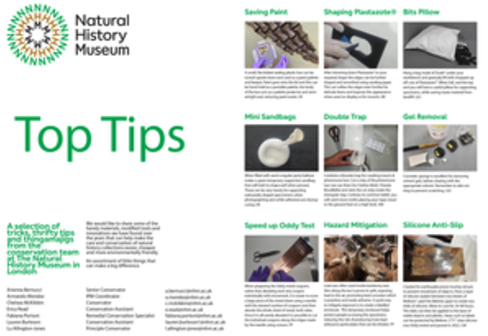 Erica Read, Arianna Bernucci, Armando Mendez, Lu Allington-Jones, Lauren Burleson, Fabiana Portoni
Erica Read, Arianna Bernucci, Armando Mendez, Lu Allington-Jones, Lauren Burleson, Fabiana Portoni
Abstract
We would like to share some of the handy materials, modified tools and innovations we have found over the years that can help make the care and conservation of natural history collections easier, cheaper and more environmentally friendly.
An assortment of little things that can make a big difference.
Policy-making Support through Open Scientific Collections from the Natural History Domain
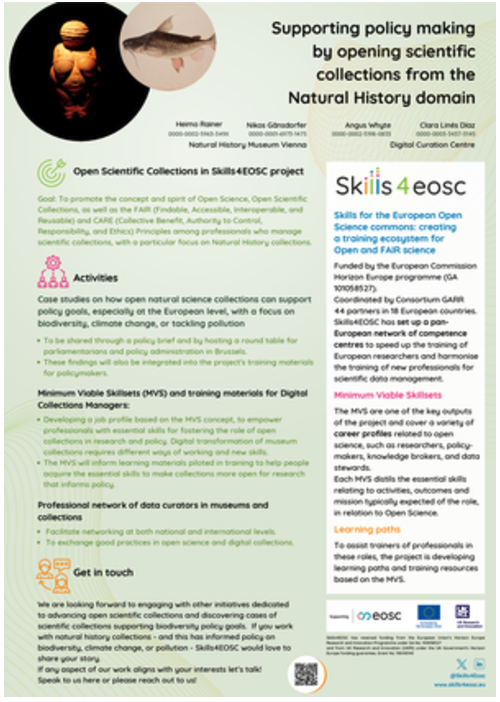 Nikos Gänsdorfer ORCID iD1, Heimo Rainer ORCID iD2, Clara Lines Diaz ORCID iD3, Angus Whyte ORCID iD3
Nikos Gänsdorfer ORCID iD1, Heimo Rainer ORCID iD2, Clara Lines Diaz ORCID iD3, Angus Whyte ORCID iD3
2NHM Vienna, Vienna, Austria.
3Edinburgh Napier University, Edinburgh, United Kingdom.
Abstract
Natural History Museum Vienna (NHMW) is working with the Digital Curation Centre (DCC) and partners in the Skills4EOSC project. Our goal is to promote the spirit of Open Science, Open Collections and the FAIR principles to professionals who manage scientific collections, and Natural History collections in particular.The project includes several tasks that involve collaboration on the following activities:
(1) Case studies on how open natural science collections can support policy goals related to biodiversity, pollution, and climate change, especially at the European level. The case studies will be shared through a policy brief and a round table for parliamentarians and policy administration in Brussels and will be used in the project’s training materials for policymakers.
(2) ‘Minimum Viable Skillset’ (MVS) for Digital Collections Managers. Since digital transformation of museum collections also requires different ways of working and new skills, we are developing a job profile based on this MVS, and piloting training materials to help people acquire the essential skills to make collections more open for research. The MVS are one of the key outputs of the project and cover a variety of career profiles related to open science, such as researchers, policy-makers, knowledge brokers, and data stewards. To assist trainers of people in these roles, the project is developing learning paths and training resources based on the MVS.
(3) We are establishing a professional network of data curators in museums and collections, both nationally and internationally to facilitate the exchange of best practices around open science and digital museum collections.
At TDWG2024, we are looking forward to engaging with other initiatives working towards open scientific collections and discovering cases of scientific collections supporting biodiversity policy goals. If you work with natural history collections and any aspect of our work aligns with your interests let’s talk!
https://cordis.europa.eu/project/id/101058527
https://www.skills4eosc.eu/
Funding Program
SKILLS4EOSC is funded by the European Commission Horizon Europe programme (GA 101058527).
On the history of a Mexican Paleontological collection
 Violeta A. Romero-Mayén ORCID iD, Jesús Alvarado-Ortega ORCID iD
Violeta A. Romero-Mayén ORCID iD, Jesús Alvarado-Ortega ORCID iD
Abstract
In 1888, under the government of Porfirio Díaz, the Mexican State took a firm step to recognize and take advantage of the geological resources of its territory. This is how the Instituto Geológico was born. In 1929 this institution was incorporated into the Universidad Nacional Autónoma de México. From its origin, institute researchers made great efforts to create and maintain a paleontological collection. Yet, the functionality and structure of this fossil repository were precarious.
Twenty years ago, in January 2004, the national character of this collection was recognized renaming the collection “Colección Nacional de Paleontología”. This act resulted after 35 years of hard work of Dr. Perrilliat Montoya as the first Collection Coordinator. She led the reorganization of collections, formalized the curation procedures, and established the criteria and policies that govern the functions and services provided by this collection.
Today, this emblematic collection is at a dangerous critical point. A growing number of specimens requires more space and material resources. New tasks, like photography, 3D digitization, and additive manufacturing, involve renovating spaces. Also, we need to re-adequate our policies to solve the repeated bad practices detected in old and new users because of the gaps in current guidelines. Here, we present our status as the main Mexican fossil collection, thoughtfully analyzing our needs and limitations.
Fishes, amphibians, and reptiles in the Illinois Natural History Survey Biological Collections.
Abstract
Founded in 1858, the Illinois Natural History Survey (INHS) is one of the oldest biological surveys in the United States. The INHS is housed in the Prairie Research Institute of the University of Illinois at Urbana-Champaign. The INHS Fish and Herpetology Collections hold thousands of voucher specimens collected through early state surveys, scientific research projects, and recent assessments conducted by INHS scientists and external researchers. These voucher specimens and associated metadata provide baseline information to study the diversity, life histories, and ecology of species of Ichthyofauna and Herpetofauna in Illinois. Therefore, the specimens are a crucial part of the biological memory and natural heritage of the state. However, the importance and reputation of the INHS Fish and Herpetology Collections extends beyond Illinois' geographical and political boundaries. Together, the collections keep about 1.3 million vouchers of fishes, amphibians, and reptiles. These specimens are reference material to 203 families, 987 genera, and 2,950 species of fishes, and 91 families, 670 genera, and 2506 species of amphibians and reptiles found in over 50 countries around the world. These vouchers are the raw material for potential novel discoveries and provide crucial information for tracking life history changes and geographical distributions as human interactions continue to modify habitats globally. Moreover, they provide important taxonomic, evolutionary, ecological, genetic, behavioral, and physiological information to address a wide range of scientific questions worldwide. Both the Fish and Herpetology Collections have continued to grow at steady rates over the past ten years with specimens being deposited from Illinois and other national and international localities. The INHS is committed to making all voucher specimens, and extended specimen data, accessible to the science community worldwide. The associated data of both world-class collections are fully digitized and can be accessed through the INHS Biological Collections website.
Downstream Tools and Contributions to Biodiversity Data Standards within the Terrestrial Parasite Tracker Thematic Collections Network
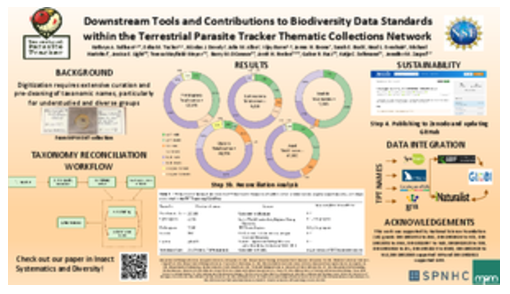 Kathryn Sullivan ORCID iD1,2, Erika Tucker ORCID iD1,3, Nicolas Dowdy1, Julie Allen4, Vijay Barve5, Sarah Bush6, Neal Evenhuis7, Michael Hastriter8, Jessica Light9, Teresa Mayfield-Meyer10, Barry OConnor11, Jorrit Poelen12,13, Gabor Racz14, Katja Seltmann13, Jennifer Zaspel1,2
Kathryn Sullivan ORCID iD1,2, Erika Tucker ORCID iD1,3, Nicolas Dowdy1, Julie Allen4, Vijay Barve5, Sarah Bush6, Neal Evenhuis7, Michael Hastriter8, Jessica Light9, Teresa Mayfield-Meyer10, Barry OConnor11, Jorrit Poelen12,13, Gabor Racz14, Katja Seltmann13, Jennifer Zaspel1,2
2Marquette University, Milwaukee, WI, USA.
3Biodiversity Outreach Network, USA.
4Virginia Tech, Blacksburg, VA, USA.
5Natural History Museum of Los Angeles County, Los Angeles, CA, USA.
6University of Utah, Salt Lake City, UT, USA.
7Bishop Museum, Honolulu, HI, USA.
8Brigham Young University, Provo, UT, USA.
9Texas A&M University, College Station, TX, USA.
10The University of New Mexico, Albuquerque, NM, USA.
11University of Michigan, Ann Arbor, MI, USA.
12Ronin Institute, USA.
13University of California Santa Barbara, Santa Barbara, CA, USA.
14University of Nebraska, Lincoln, NE, USA.
Abstract
Mobilizing data from millions of arthropod specimens in collections across the United States greatly enhanced the available data for research on terrestrial ectoparasitic groups, but our work also generated products that are useful to the entire biodiversity data community. The Terrestrial Parasite Tracker Thematic Collections Network project developed a workflow for gathering expert-verified taxonomic names across all available sources, aligning those sources, and publishing a single resource that provides a model for future endeavors to standardize digital specimen identification data. The process involved gathering expert-verified nomenclature lists representing the full taxonomic scope of terrestrial arthropod parasites, documenting issues experienced, and finding potential solutions for reconciliation of taxonomic resources against large data publishers. In addition to reconciling taxonomies, characterizing biotic interaction data also required dedicated teams to standardize ontologies and provide data entry support for many platforms. At the end of the project period, which had the primary goal of digitizing specimen data from natural history collections, we highlight the other tools created to facilitate rapid digitization and integration of data. Here, we demonstrate a mechanism for the delivery and continued maintenance of these resources, while highlighting the applicability to digitization and biodiversity data managers globally.
Funding Program
The project was funded with National Science Foundation award DBI-1901932 to JZ.
A museum display showing real-time bird vocal activity using BirdWeather/BirdNET
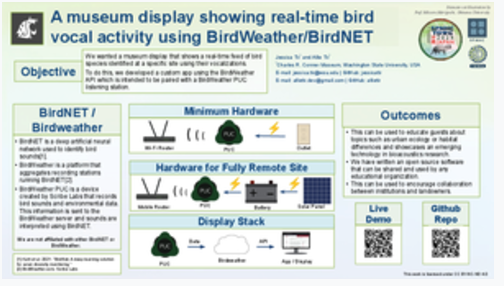 Jessica Tir ORCID iD, Allie Tir
Jessica Tir ORCID iD, Allie Tir
Abstract
We designed a dynamic museum display that shows a live feed of local birds’ vocal activity with AI-powered species identifications. To do this, we deployed BirdWeather PUCs (Portable Universe Codecs) in the field to continuously collect and report real-time vocal and environmental data. The vocal data are interpreted by BirdWeather via the BirdNET artificial neural network which returns species identifications. We designed a custom interface using Flutter to create visualizations of the bird occurrences and environmental data. Visitors can interact with the display to generate and explore questions about how call frequency and species composition can be influenced by environmental variables. This display prompts visitors to think like bioacousticians and connects them to the animals in their local ecosystems.
The code and setup instructions will be available in a GitHub repository to allow other groups to reproduce this display in their own galleries using their own local birds.
Object location tracking in the Malacology Collection at the Museum of Comparative Zoology
Abstract
How do museums keep track of the things that we have? A report based on the 78 largest museums and herbaria worldwide estimates that they house over 1.1 billion objects. Museum collections are an important repository for historical and current research specimens. Therefore, the tools used to store, track, and document object movement, have long-lasting implications. The Malacology Collection at Harvard University's MCZ has digitized just under 400,000 cataloged lots on MCZbase, a museumwide online database, and estimates that another 300,000 uncataloged lots, including dry and fluid material, microscope slides, and bulk samples remain. With ongoing digitization, physical rearrangement, and loans, object containers allow for specimen tracking and bulk inventories. The MCZ utilizes several methods of specimen/lot tracking, including specimen object containers, physical placeholders, and barcodes. With the development of robust collection databases, and bulk object tracking, best practices continue to be developed. The ability to locate objects within a museum collection is paramount in keeping order when curating large collections and will continue to evolve with the addition of new technologies.
Significance of Extraregional Surveys - Contribution to Comprehensive Historical Exhibition of the Regional Museum through Interregional Comparisons of “Familiar Insects”
Abstract
In order for a local museum to exhibit natural history in a limited space, the following items should be prioritized in its animals and plants collection: 1) animals and plants in each natural environment characteristic of the local area, 2) fossils and remains excavated in the local area, and 3) animals and plants that have changed with the urbanization of the present day. The presenter's museum is planning a major renewal of its exhibits in the near future, and one of its tasks is to integrate natural history exhibits with historical and folklore exhibits, which have been separated from natural history exhibits, in a comprehensive and historical manner. While many of the animal and plant materials mentioned in 2) above can be placed in various parts of the general history exhibits from geohistory to history, it is difficult to solve the same problem for insect materials because the number of insect remains is extremely small compared to the number of species that can be observed close at hand. "Familiar insects" are a set of species of the current insect fauna of an area that can be followed by many people, and are an important component of the earliest remembered scenery for children. The presenter is conducting a survey of "familiar insects" in various areas where the present and future climate, topography, and land use patterns that define the insect fauna of each period, from prehistory to modern times and into the future, in the museum's field are assumed or predicted to match today. The collection and information accumulated through this survey will greatly extend the time period covered in 3) above, and will enable the placement of insect collections at various locations throughout the historical exhibition of the region's past and future.
Funding program
This project was supported by JSPS KAKENHI Grant Number JP21K01011.
History of the Yale Peabody Museum Invertebrate Paleontology Collection
Abstract
While the Yale Peabody Museum itself did not exist as an entity until 1866, the collections that are its core have been on campus much longer. Yale College had a cabinet of natural wonders dating back to the American Revolution. This “Cabinet of Yale College” had been housed in multiple places around campus prior to the construction of the Peabody Museum. Some of the earliest collections came from exchanges between Benjamin Silliman and Gideon Mantell. It wasn’t until 1876 when the first Peabody Museum building opened that the museum had both its own identity and space. The appointment of Charles Beecher in 1888 gave the invertebrate paleontology collection its first dedicated staff member. Under Beecher the collections continued to grow with multiple accessions from Syria, Lebanon, and Palestine. By the late 1860s, fossils from the American West were being shipped back to Yale by train. Marsh’s dinosaurs are the most well-known, but the invertebrate paleontology division received extensive collections of Western Interior Seaway specimens. Charles Schuchert took over the division in 1904, bringing with him an extensive collection of brachiopods that he continued to expand over his lifetime. Graduate student dissertation collections significantly grew the collections throughout the twentieth century. Significant additions in the last quarter century include the Samuel J. Ciurca Eurypterid collection, an Early Ordovician Fezouata Formation lagerstätte collection, the CLIMAP collection of foraminifera slides and vials, and an incredibly diverse collection of Green River Formation insects. Many fossils are on display in the newly renovated Yale Peabody Museum which reopened in April of 2024.
Extended abstract in Biodiversity Information Science and Standards (BISS)
Salvage Planning and Training in the Natural History Museum Galleries
Abstract
The Natural History Museum is home to over 80 million specimens across sites in London and Tring in Hertfordshire, UK. Only a fraction of these specimens are displayed at any one time, however, displays include some of the Museums most iconic and important specimens. Parts of the building in South Kensington, designed by Alfred Waterhouse in the 19th century, are also of considerable architectural significance.
Although it is impossible to plan for every eventuality, it is useful to consider salvage of specimens across a number of possible scenarios and ensure that staff are confident in applying their training to real situations. This presentation will examine the risks to collections on display, the importance of effective emergency planning, selection of priority specimens, in-situ protection, recovery and staff training opportunities. Engaging staff with clear and robust training is essential in mitigating potential damage or loss including minimising of risk to both collections and staff.
Earth system’s biology Data FAIRification: Mobilizing SGN Collection Data for the BITS terminology service in Earth System Science
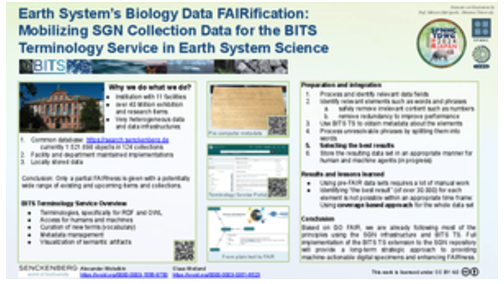 Alexander Wolodkin ORCID iD, Claus Weiland ORCID iD
Alexander Wolodkin ORCID iD, Claus Weiland ORCID iD
Abstract
In the highly interdisciplinary Earth System Approach we observe interactions between atmosphere, hydrosphere, biosphere and geosphere. As a part of the ESS, Earth systems biology is also an interdisciplinary field, containing biology, ecology and other biodiversity-related fields.
As a partner of the BITS Terminology Service, Senckenberg should in particular provide biological collection data, e.a. from its herbarium. The BITS partners aim to close the gap to the application of FAIR principles in Earth System Science by addressing data interoperability of research data.
FAIR Terminology Service using the BITS implementation including machine learning approaches like Reverse Dictionary and FAIR mappings using e.a. mapping.bio (TDWG 2023, https://doi.org/10.3897/biss.7.111979) are a part of the strategy to increase the collection FAIRness and machine based processability. In that way the long term goal is to provide machine actionable Digital Specimens.
In general the use of semantic artifacts is currently not the common case at all. Using biology collection data for this purpose requires mappings for words and phrases, such as descriptions in various languages and contexts. Not many publishers are able to process such data, mostly in a manual way. Using the Reverse Dictionary, non-standardized terms can be linked to corresponding terms from semantic artifacts. This can be a great support for research in the biosphere, but also in related fields, e.g. ecology, climate, or even other fields.
The use of terminologies improves FAIRness. Mobilizing collection data is a part of the process of gathering new experience to create blueprints that will later be used to connect other Earth System Science repositories to the BITS Terminology Service.
Funding Program
Funded by DFG (German Research Foundation). DFG project number 508107981.
EcoBank: Pioneering Standards for Ecological Data Sharing and Utilization in South Korea
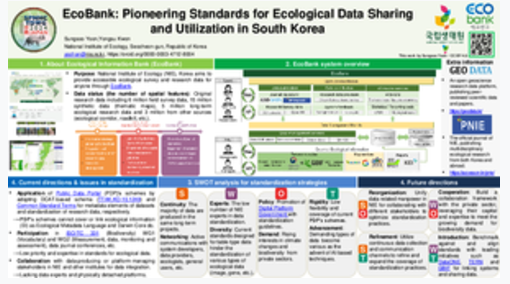 Sungsoo Yoon ORCID iD, Yongsu Kwon ORCID iD
Sungsoo Yoon ORCID iD, Yongsu Kwon ORCID iD
Abstract
EcoBank plays a crucial role in collecting, standardizing and disseminating biodiversity information in South Korea. Initially established to integrate and share ecological survey data at a national level, EcoBank has expanded its data acquisition beyond national borders and through citizen science-based biodiversity surveys. One of the central missions of Ecobank is to commit to the ecological data standardization to facilitate efficient data sharing and utilization. Adhering to Common Standard Words and Terms approved by the Ministry of Interior and Safety of South Korea, and the structure of relational database management system, EcoBank continually seeks to embrace internationally recognized biodiversity-related data and metadata standards. This effort not only ensures compatibility and interoperability with ecological data from various sources but also highlights the necessity of examining gaps, opportunities, limitations and future directions in the current standardization initiatives of EcoBank. This study reviews data and metadata standards applied to similar biodiversity data platforms and conducts a SWOT analysis to assess EcoBank's technological assets, human resources, regulatory frameworks, along with internal and external requirements. This analysis will identify strengths, such as EcoBank's extensive network and data collection capabilities, weaknesses such as potential gaps in data standardization practices, opportunities for integration with international data initiatives, and threats including technological lags and institutional constraints. The findings are intended to guide strategic planning of ecological data standardization, enhancing EcoBank's contributions to both national and international biodiversity information communities.
Funding Program
National Institute of Ecology (NIE), grant number: NIE-B-2024-01.
